The Secret Lives of Lumpfish [Podcast]
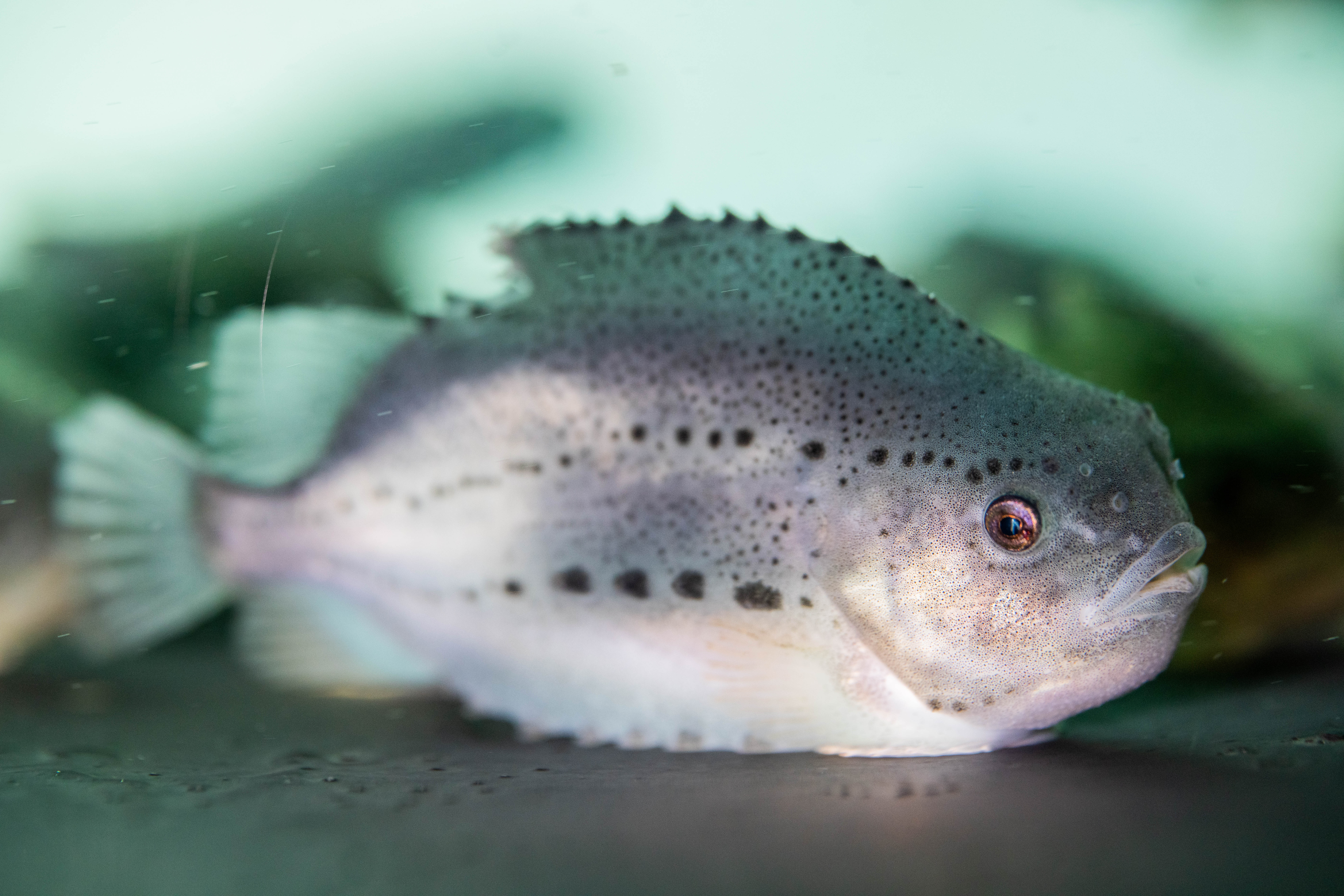
Show Notes
They’re round, suction-cupped, and as it turns out, full of secrets. Lumpfish (Cyclopterus lumpus) may not be glamorous, but these quirky creatures are doing serious work beneath the waves in the Gulf of Maine.
In this episode, we learn how lumpfish are becoming unlikely heroes in salmonid aquaculture. Acting as ladybugs of the sea, they help control parasitic sea lice in salmon and trout farms—a natural solution to a major problem. But what do we know about the lumpfish themselves, and what happens when we rely on wild species to fix our finfish-farming challenges?
Act One: Elizabeth Fairchild from the University of New Hampshire describes her latest Sea Grant-funded study on lumpfish. The study seeks to shed light on the mysterious lives of lumpfish in the rapidly changing Gulf of Maine, and their potential for use as ‘cleaner fish’ in salmonid aquaculture operations.
Act Two: Sam Rutka and Aravis Albert from the Seacoast Science Center explain how lumpfish can help us tell the story of a changing Gulf of Maine, and where curious coastal visitors can look to find these charismatic fish.
Full episode transcript available below.
Guest Speakers
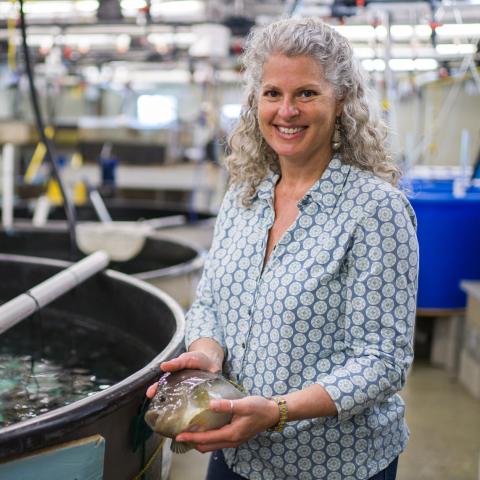
Elizabeth Fairchild, Ph.D.
Research Associate Professor, Biological Sciences, University of New Hampshire
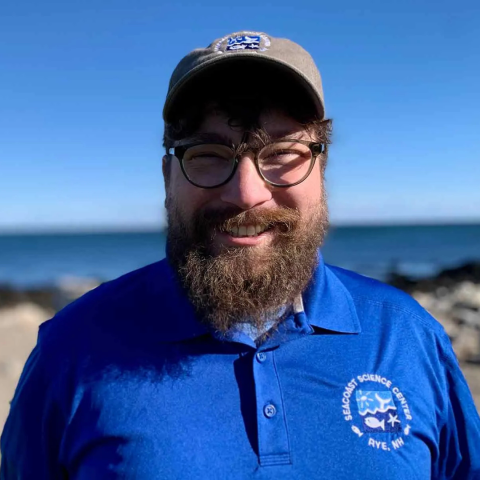
Sam Rutka
Lead Aquarist, Seacoast Science Center
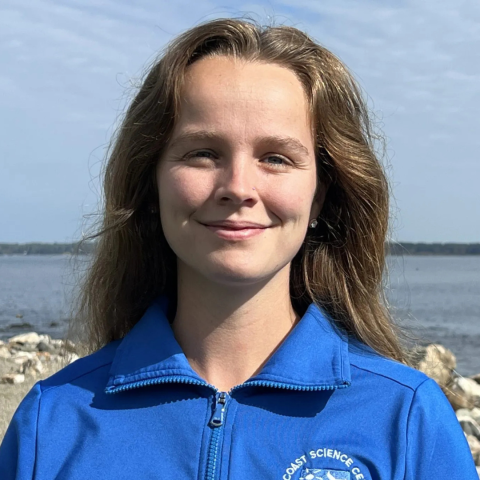
Aravis Albert
Aquarist I and Naturalist, Seacoast Science Center
Meet Your Hosts
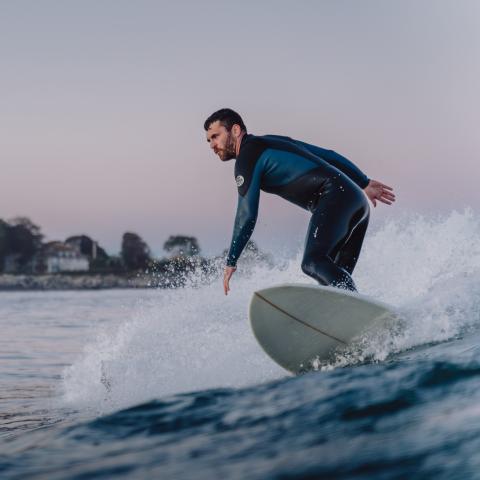
Brian Yurasits,
Host & Producer
Science Communication Specialist,
New Hampshire Sea Grant
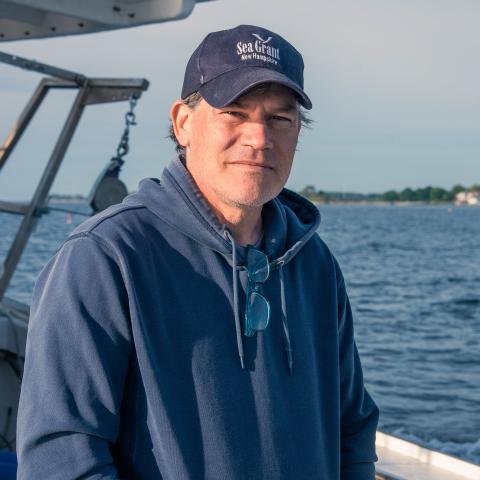
Erik Chapman, Ph.D.,
Co-host
Director, New Hampshire Sea Grant
Interim Director, UNH School of Marine Science and Ocean Engineering
Episode Transcript
Brian Yurasits: [00:00:00] What is your favorite color of lump fish?
Elizabeth Fairchild: That's really tough because there are so many colors and they're all sort of in my, my color wheel, teal, orange, fuchsia, I don't know, I love them all.
Brian Yurasits: Okay. Okay. So, so this is the like when they're, uh, in their mating colors?
Elizabeth Fairchild: Well, the females and in non- mating season, the males, um, tend to be sort of a teal, tealy gray.
But during mating season, the males then become very colorful from, they look like Skittles, you know?
Erik Chapman: Is that when orange happens?
Elizabeth Fairchild: Yeah. Orange, fuchsia, purple, yellow.
Brian Yurasits: There's this strange little fish in the Gulf of [00:01:00] Maine called the lump fish that kind of looks like a swimming rock with a face. And while they may not be winning any beauty contests, they're playing a crucial role in the changing ecosystem of New England's waters. Scientists are studying them to map where they live, how they move, and why they matter, not just for the ocean, but for us.
Today we're joined by Dr. Elizabeth Fairchild, research associate professor of biological sciences at UNH, who is trying to crack the code of this peculiar little fish with her sea grant funded research, because sometimes the smallest creatures tell us the biggest stories. I'm your host, Brian Yurasits, joined by my co-host, Erik Chapman, and this is Time and Tide.
So, so yeah. Erik? Yes. For anyone listening to this podcast who has never seen a lump fish before or maybe ever even heard of one, how would you describe how these [00:02:00] little critters look?
Erik Chapman: Well, it's a good thing they're named pretty well, 'cause they kind of look right off like a lump and lumpy. When they're oriented to the side, they're sort of circular almost, and they've got small dots on them. And I think one of the things that you remember the most when you, when you see one, is their eyes. To me, their eyes, just sort of almost fixated on me and they have sort of a, I don't know, it's almost a human quality. They're looking like they want to kind of reach out and talk to me or something.
I don't know.
Brian Yurasits: Yeah, I think that's a good way to put it. Uh, Elizabeth, would you add anything to that? Like
It was a non-scientific, now let's ask the scientist who studies them.
Elizabeth Fairchild: Yeah, that's a pretty good description. So, I, I, when I try to describe lump fish, they're, they're kind of a clunky looking fish. Kind of shaped like a Nerf football, but with, as Erik said, these dots, these tubercles like bumps all along the sides of them.
They have really big eyes and, and yes, they have a lot of personality, [00:03:00]
Brian Yurasits: Like what's on the bottom of their body?
Elizabeth Fairchild: So one set of their fins is modified to form a sucker like a suction cup, and they hatch out of eggs with that sucker, so they stick to any available smooth surface.
Erik Chapman: They're doing that their whole lives.
Elizabeth Fairchild: Their whole lives. Wow. Yeah. They're, you know, they're not streamlined. They're not like, you know, a salmon or a tuna or anything. So, um,
Brian Yurasits: Do they prefer to stick to certain substrates or like, do they prefer rocks? Do they prefer, like you mentioned, they stick to each other sometimes?
Elizabeth Fairchild: Yeah, they tend to go for the smoother surfaces.
So like a kelp blade, um, or a smooth pier piling or smooth rocks. Um, or in the case of when we're growing them in tanks and we have a lot of them in the tanks and there isn't a tank surface to stick to, they'll stick to each other.
Brian Yurasits: Why, like, biologically do they have this adaptation?
Elizabeth Fairchild: You know, I don't know why evolutionarily they adapted to have this, this [00:04:00] sucker.
Um, but it fits in with just their life history patterns of, of being sort of a, a lie and weight kind of predator. Meaning they're not going out and searching for their food. They're just hanging tight. They're like a couch potato waiting for somebody to deliver the bowl of potato chips to come.
Erik Chapman: Well, I would imagine it, it saves energy.
Exactly. You know? Exactly. If they're just locked onto something, they don't have to swim. They don't have to they just, they're locked on. And so I would imagine their life is about positioning themselves in a place where they're gonna get food.
Elizabeth Fairchild: Absolutely. Except for they do have these pretty crazy migrations associated with spawning where they really, they move from offshore, the adults move from offshore to inshore, to spawn.
Erik Chapman: Oh my gosh.
Elizabeth Fairchild: And then at a certain point, you know, after the eggs hatch out, after these little juvenile, um, lump fish grow to a, a certain size, they too move offshore with the adults.
Erik Chapman: Wow.
Elizabeth Fairchild: So that, that definitely takes up a lot of energy.
Brian Yurasits: Is there something that triggers that, uh, season ? And, and [00:05:00] when, when does that occur, that migration?
Elizabeth Fairchild: Great questions. I'm not sure I can answer them all. Like I don't know specifically off the top of my head what might trigger it other than water temperature and photo period. The change in daylight. Those seem, those are the triggers often with fishes and when they spawn and when they move.
Erik Chapman: Is that a common theme with this species?
Just there's a lot that we don't know.
Elizabeth Fairchild: Absolutely. Yeah 'cause we've never harvested them, meaning we've never gone and fished for them either recreationally or commercially in US water. So what we know about them is either from studies that have been done in other countries, um, or um, just sort of incidentally somebody catches a lump fish and describes it.
Erik Chapman: What brought you to study lump fish? What was sort of the, the gateway the pathway that took you to look at lump fish and start learning about them.
Elizabeth Fairchild: So I, um, started researching lump fish from an aquaculture standpoint. Um, they're used as [00:06:00] biological de-lousers or as an animal that will eat parasites off of other fishes.
So sort of like, um, you know what you might imagine when you watch National Geographic special and you see Caribbean reef cleaning station with a big parrot fish and little wrasses coming in and out and cleaning the parrotfish. Lump fish have the same behavior, um, and they are used in Atlantic salmon and stealhead trout aquaculture operations.
When, when these salmonids are raised in ocean cages, they get, um, a naturally occurring parasite called sea lice. Um, Europeans discovered that lump fish have this cleaning behavior. If you put them in the cages with the Atlantic salmon or the stealhead trout, they'll eat the sea lice off of the salmonids, so I came in into it from that angle, looking at it like, wow, okay.
So these lump fish are used by other countries for this parasite removal process in aquaculture. [00:07:00] That's really cool, and maybe that's something we should do in the US with our Atlantic salmon and stealhead trout farm operations.
Erik Chapman: How do they currently deal with this as a challenge?
Elizabeth Fairchild: Parasite control has changed over the years, so it used to be that you could dump a bunch of chemicals or, um other pharmaceutical components into the, these cages, um, to help control or eliminate parasites. That, intuitively is not a great idea and has been banned, so that's no longer happening in US waters. Instead, the Atlantic Salmon Farms in Maine state waters use mechanical treatments, so they'll do something like, they'll expose the the salmon to fresh water treatments when they're grown in salt water, and that will knock the sea ice off, or they'll expose 'em to a different water temperature and that will also knock sea ice off.
Erik Chapman: So that, that sounds like either a lot of [00:08:00] work or like dumping chemicals in the ocean, which doesn't have a good ring to it either.
Elizabeth Fairchild: No. And is illegal now.
Erik Chapman: Yeah.
Brian Yurasits: Where have we historically been able to find information about wild lump fish ?
Elizabeth Fairchild: There are fisheries for lump fish in Europe and in the Eastern Canadian provinces.
So there's a lot of information then associated, um, with where and when lump fish are caught and their, um, natural history, their ecology, their movements. And so we can look to those studies and, and those data sets to learn. And there's been, um, a few studies, even a couple, um, conducted at UNH, um, by past graduate students about distribution of juvenile lump fish, uh, in New Hampshire water.
So there's a little bit of information here and there, but again, because they haven't had a commercial importance or, or use yet in US waters, they've been overlooked.
Brian Yurasits: That, that's something very interesting, uh, that I want to kinda transition to [00:09:00] is, is your, your recent Sea Grant funded study that you've done.
Elizabeth Fairchild: Europeans raised 40 million lump fish a year for their use as um, sea lice control in their atlantic salmon and stealhead trout cages. Why can't we do that too? I thought piece of cake raising lump fish. That's a relatively easy marine species to, to raise, but you gotta start somewhere. And so I was like, well, I'll just work with our commercial fishermen and bring in some adult lump fish before they spawn and start the process.
We used to be able to catch them. Um. We couldn't, several years we struck out, we were not able to find the fish we were looking for where we used to find them. So that was like the first incidence of uh oh. What's going on here? Then as we got further along in our aquaculture research, we realized there may be sooner than we expected a use for lump fish in US waters, and we really don't know anything about the wild lump fish [00:10:00] populations in the Gulf of Maine.
How you know the biomass, how how many there are out there. We just have some generalizations, and what happens if all of a sudden there's gonna be a fishery for lump fish? What would that do?
Brian Yurasits: In terms of using them for aquaculture right, you mentioned that there'd be a demand, a, a potential demand for a fishery to support this need in aquaculture.
Do you see, uh, that we'd be getting these lump fish from wild stock? Uh, like how, how many would we like, potentially need for aquaculture
Elizabeth Fairchild: In order to, you know, start culturing a population of animals? You have to, you have to start with, find your starter population, so to speak. Um, and so in the case of fish, you need to start with some adult fish that you can spawn to get fertilized eggs.
Um, we could easily reach out to another country that has lump fish aquaculture and say, Hey, can you ship us some fertilized eggs? But that is not a responsible way to do it because then we would be importing animals from a different [00:11:00] region of the Atlantic Ocean with a genetic, different genetic structure.
So we want to be representative of what's in our backyard, what's in the southern Gulf of Maine.
Erik Chapman: Why aren't, um, folks that are raising fish in Maine or in the US using lump fish now? What's sort of the barrier for them?
Elizabeth Fairchild: The novelty of it, I think, and regulations.
Erik Chapman: Okay. So our, our sort of, our regulatory systems need to be able to set up a system and manage it in a way that is sustainable for the aquaculture and the wild fishery of lump fish.
Exactly. For example, and we, we don't have that information. That's why your research is important.
Brian Yurasits: So I know a big, uh, a focus of your recent paper that that and Sea Grant funded research was, um, to see if the warming Gulf of Maine is, is changing where lump fish spend their time, and are they kind of like a canary in the coal mine In terms of, uh, the impacts of, of climate change [00:12:00] on Gulf of Maine and the species that, like our local species here.
Elizabeth Fairchild: We suspected that due to the warming waters of the Gulf of Maine, uh, where every year we seem to be hitting a new high and due to like our own uh, prior failed attempts to find lump fish where we used to be able to collect 'em, we figured, huh, I wonder if water temperature, the change in water temperature is affecting where lump fish are now. We, we hypothesize that water temperature was affecting, um, where we find lump fish over time, and because they haven't been fished at all, um, they could perhaps be a sentinel species like that canary in the coal mine.
Brian Yurasits: So it's kind of like a clean slate to study in a way.
Elizabeth Fairchild: Right.
Brian Yurasits: And before getting into what you're, what you found, 'cause I know we're all curious about where are, where are the lump fish, right? Yeah. Um, anyone out there who's interested in this can access this information, correct?
Elizabeth Fairchild: That is [00:13:00] correct, yes.
Brian Yurasits: Where can they find this?
Elizabeth Fairchild: I should back up and say that. So this project that was funded by New Hampshire Sea Grant was not mine alone. I had great collaborators um, here at UNH. Um, they include Easton White, he and his grad student, Sophie Wolfing and members of the White lab did data analysis.
Shane Bradt, um, from Cooperative Extension, designed this incredibly beautiful story map and interactive mapping tool, and that's available to anybody. Um, you can find it online and, um, with that you can, um, read up on lump fish, sort of like their natural history, see some pictures at all different ages and developments.
Um, learn about how they're used in responsible aquaculture, and then you have access to the data that, that we played around with, um, and learned where lump fish are. You can toggle different layers on and off and look at the whole time [00:14:00] series of data.
Erik Chapman: It sounds like it's an invitation to scientific inquiry.
Elizabeth Fairchild: Absolutely. Yeah.
Erik Chapman: For anyone out there, yeah,
Elizabeth Fairchild: You do not have to be a scientist, you can just go and look at pretty pictures of fish. Or you can play with the data to all levels of the, the data has been used to develop high school science modules. Um, undergraduates have gone in for manipulating and clean the data.
Graduate students have used it for, for modeling purposes.
Erik Chapman: A teacher could kind of maybe sick their students on it, say, well, you know what, what can we learn with this? Explore the data.
Brian Yurasits: What did you look for, when you were looking at this data and, and what did you find?
Elizabeth Fairchild: Well, statistics, what we found was that lo and behold, water temperature is affecting lump fish distribution.
And that we are finding, when we look at where they're found over time, year by year for latitude versus longitude, we're seeing that the population is shifting to higher latitudes, meaning it is shifting [00:15:00] northward. Which is not unexpected. If you have a cold water fish and it's getting toasty, they're gonna be moving to where it's a little bit cooler.
Erik Chapman: What, and can you remind me what is their distribution geographically?
Elizabeth Fairchild: Well, they used to be as far down as New Jersey. Okay. Um, but I'd say it is probably hard pressed to find a lump fish that far south. Really, Gulf of Maine, um, kind of around Cape Cod a little further south. Yes, you can find 'em. Um, but these are cold water fish.
I mean, right now when the water's near freezing, they're loving it.
Erik Chapman: And do the, does their distribution range north to like Labrador further?
Elizabeth Fairchild: Yes. And further. So they're, they're on up into, into some pretty chilly. Zones,
Erik Chapman: You know, this stage of sort of exploring data, it seems like it's rich in generating new potential areas of inquiry. Yeah. New questions. What's maybe one that you [00:16:00] are kind of are hot on the tail of?
Elizabeth Fairchild: We did find something surprising, at least it was surprising to me in the data, and as I mentioned, these fish have inshore offshore migrations associated with spawning, and we know that sort of these coastal and estuarine areas are nursery grounds for young lump fish, the ones that have just hatched out, they're, they're hanging out in these shallow nutrient rich waters, um, for the first summer, um, or year of their life before they move offshore. What I was really surprised to see was when we looked at these data, there were instances of catching these really small, young lump fish way offshore, and I thought at first it was an error.
But there were a lot of these incidences and I thought, what's going on here? Why are they offshore? So to me, I'm drawn towards the question of what is going on? Are these young fish that the currents are taking them offshore, which does happen with several species, or because we have all of these shallow [00:17:00] banks in the Gulf of Maine, are those spawning areas for lump fish?
Brian Yurasits: Do you plan to kind of build off of this project and, and continue your work with lump fish?
Elizabeth Fairchild: I hope so. We'll continue our work with lump fish, um, because we find that it's an important fish to bring attention to, um, in light of the growing aquaculture industry and community. Um, and you know, if we're gonna use them responsibly in aquaculture, we have to manage them responsibly in the ocean as well.
Brian Yurasits: And they're a charismatic, I would consider them a megafauna.
Erik Chapman: They're, well, I was just wondering about that. They're definitely charismatic, but are they a megafauna? And if they're not, what's the term for them? Charismatic mini fauna?
Elizabeth Fairchild: No, they're, they're definitely mesi. The way they eat, they're, they're definitely not mini.
Okay. Megafauna.
Brian Yurasits: Megafauna. Let's stick with that.
Elizabeth Fairchild: But definitely charismatic.
Brian Yurasits: Yes. They're definitely a species that I feel like people can see themselves in, in one way or another. Well, thank you [00:18:00] Dr. Elizabeth Fairchild for sitting down with us and telling us about your work.
Elizabeth Fairchild: Thank you for having me. Thank you for shining a spotlight on this.
Brian Yurasits: For the second act of this tale about lump fish, we'll be visiting the Seacoast Science Center in Rye, New Hampshire to see what Aravis Albert and Aquarist and Naturalist and Sam Ruka Lead Aquarist have to say about how lump fish are helping them to educate visitors about the Gulf of Maine.
I'm here at the Seacoast Science Center. We walked through the doors, greeted by, you know, so many sounds of kids, uh, families experiencing, uh, this location here at Odiorne Point State Park in Rye, New Hampshire. We are recording in the Sugden house, uh, with two of the science centers, Aquarists and Educators, Sam and Arvis.
So I'm super excited to be joined by you both. What is your favorite thing about having lump fish at the [00:19:00] Seacoast Science Center and having them as an educational tool, I guess?
Sam Rutka: Well, there are many things that I love about lump fish, but one of my personal favorites is the scientific name is Cyclopterus lumpus, and if you look into the etymology, um, Cyclopterus coming from the greek word kyklos, which means circle, and essentially their name, Cyclopterus lumpus translates to Lumpy Circle. And if that's not one of the most illustrative names for a creature, I don't know what is. They're just these exceptionally adorable little creatures that are staring out just as we stare in and it's a great way to get people curious and interested about the animals that live just here in our backyard.
Aravis Albert: I agree with Sam. I think that the lump fish are really adorable and I think that visitors really love them and [00:20:00] it's really magical to see their little faces light up, especially the kiddos when they see them, especially if you're doing a program, if we're educating about them, if we're doing a feeding and they get to watch them eat.
Brian Yurasits: Do you think the lump fish's faces light up? Too when people are looking at them.
Sam Rutka: I think if, if we're gonna use the analogy of faces lighting up, I think there might be power in the house, but no one's really home. Um, but, but that's not fair. I'm, I'm sure they're, they're thinking about their, their next small meal or, or sticking to something fun.
But just looking at them, they, they seem to be having a good time. And I understand that's anthropomorphizing, but it, you can't not do it with these guys. They just, they're so funny. They're always smiling and um, and they always look somewhat surprised.
Brian Yurasits: Would you consider lump fish to be a charismatic megafauna?
And I ask this because I know that the lump fish is now on the sign at the entrance to Odiorne. And so it's the first thing that you see when you come [00:21:00] into the state park.
Sam Rutka: So I would like to first focus, charismatic, absolutely. I think they are very charismatic by definition. Um, but following the definition, I wouldn't consider them megafauna. By having them on the sign, I think one of the benefits of that is a lot of people just don't know that they exist here or exist at all. Uh, one of the things I hear the most walking through the Gulf of Maine Gallery is, what is that? You know, people look at this, this lumpy little creature, this swimming rock, and they're like, what is it?
Where is it from? And you get to tell them it's right outside. I mean. You know, it's a ways out, but it, it's in this water and, and they do look like rocks and they are lumpy and weird, but they're here and everybody knows that we have lobsters here, we're known internationally for lobsters. But to put a fish that people just aren't aware even exists at all, [00:22:00] let alone in their hometown, I think is a great way to catch the eye and, and bring some new people in that may have otherwise.
Kept driving.
Aravis Albert: Well, I think that they look like, like if you turned a fish into a rubber ducky, I think they look like a rubber ducky fish.
Brian Yurasits: I've never heard someone use that description for lump fish before, but it is so perfect.
Aravis Albert: Their little section cup pelvic fan is like the little bottom of the rubber ducky.
Brian Yurasits: I hope if anyone's listening that they can just visualize that.
Sam Rutka: I hope if anyone's listening, they can make a rubber, yes, ducky lump fish.
Brian Yurasits: And to your point, Sam, of being able to use lump fish to talk about the Gulf of Maine, this exhibit as a whole, uh, tells a story right? And I'm curious if you could talk about the, that story itself and the lump fish's place in that story.
Aravis Albert: Sure. So our Gulf of Maine exhibit is, um, it's, we've, it's called the Changing Gulf of Maine. So it's really focused on how the Gulf of Maine is changing. And we know that the Gulf of Maine is warming [00:23:00] faster than 99% of the world ocean. And so, what is happening here is really important for everyone globally.
We can all think about the research that's being done as we face these rising temperatures and how that can be used elsewhere. So the lump fish absolutely fit into that story. I think some of the research is focusing on where lump fish are found on their distribution and their population shifting northward or into deeper water.
And so we've talked about how charismatic and adorable they are, so they kind of get you hooked and then they help us tell that story about what's happening to their population.
Brian Yurasits: And if you can maybe talk a little bit too about what other species are in the changing Gulf of Maine exhibit. Like what this tank is gonna be actually one of the first ones that you see when, when you walk into the exhibit.
Um, but what other species are on display and kind of what other stories are being told in that same space. I'm curious.
Aravis Albert: Sure. So if you move on past our lump fish tank, you'll [00:24:00] see we have some black sea bass. They're a species that historically we might not have seen so much in the Gulf of Maine, and they're shifting northwards as well.
So we're seeing some of these other species that are shifting across the way you would see our lobsters. Again, this is an area where, sam mentioned, we're internationally known for having lobsters and lobster populations are shifting. Um, we also have some tanks that are featuring some of our invasive species.
So that's another issue that we're looking at our, especially our invasive green crabs and our shore crabs.
Sam Rutka: One of my favorite exhibits in the Gulf of Maine Gallery is the Gulf Stream orphans. We call it the captured in currents. Uh, and that is an exhibit that showcases these animals that you can find as far south as Mexico.
And as the waters are warming and climates are changing, they are riding further and further north in the currents and in the Gulf Stream, and they are [00:25:00] getting found in places that they weren't originally located in. So these creatures that we call Gulf Stream orphans are actually stranded up here in the fall and winter, and we can put them on display and talk about the shifts in currents and changes in ocean temperatures.
Brian Yurasits: So lump fish fit into this larger Gulf of Maine ecosystem that is on display, and that's one of the really cool things about the science center and that that, um, exhibit as a whole is that it's all local fish that you, like you mentioned Sam and Aravis that you'd find here. Uh, but the interesting thing, interesting thing is.
That what's considered to be a local species is changing through time. So you have the tank, people get hooked on the lump fish, right? They, they get inspired by these little faces looking back at them, uh, and then they want to learn more. So I'm curious if you could talk a little bit about how that mapping tool have either of you like used it yourself or looked at the information. Have you seen other visitors use this mapping tool and kind of explore it on their [00:26:00] own or students or teachers? Uh, so I'm curious if you could talk a little bit about who has used that mapping tool, um, and, and how that maybe is, um, impacted the way that they teach or that they learn.
Aravis Albert: It's right next to the lump fish tank and so they get to look at how the lump fish population has shifted over time, and it's part of this broader story that the full exhibit is telling throughout the whole room, the whole hall as you're walking through about species shifting and about the Gulf of Maine changing.
One of the other things that they can see if they look across the room from them is a map, a heat map showing the Gulf of Maine and the temperature changes over time. And so I think when you take those two maps side by side and you look on the one side, temperatures are rising and then you look at the shift in lump fish population, I think it helps kind of connect the dots and put it all together.
Sam Rutka: One thing that I enjoy is when I'm walking through the gallery, I'll look over and I'll see some kids like moving the slider on the map back and forth to show [00:27:00] like the, the change in distribution. And every once in a while you'll, you'll hear a parent being like, all right, but, but why is the slider moving?
And they're focused on the slider, but you know, and it's a great, it, it's a good icebreaker. So it gets them interacting. And then you can talk about why. And I think comparing it to the, the temperature map on the projection screen, just on the other side of the room, like Aravis said, is really a great way to bring it all together.
You can really see how everything is like a spider web and you pull on a string over here and it affects something over there and you, you pull over here and it does something over there. So, it's a great illustration for how dynamic the ecosystem is and the changes that are taking place.
Brian Yurasits: No matter how they go, they run through the room.
There's a lot of engaging opportunities like this map is right there for them to inquire about if they choose to take that journey. Right. And I'm curious if you have any [00:28:00] related to the mapping tool or not. Um, any interesting stories about visitors engaging with the lump fish tank and the mapping tool?
Aravis Albert: One, they've grown a lot since we got them. These particular individuals came in pretty little, what would you say? Like three, four inches? Um, and now the biggest one is I. Probably 10 at least.
Sam Rutka: Yeah. Uh, eight, nine, possibly 10 inches. They, they, they grow up so quick.
Aravis Albert: They do. They do. Um, so that's been really sweet to get to watch that.
We had a male who turned bright red for us. He was gorgeous when he first started to change. Um, it wasn't obvious, you know, it's, it's, it's gradual. And so he looked maybe a little red around his gills. We said, oh no, what's wrong with this guy? We pulled him off display and brought him into the back to keep an eye on him, just a breeding male.
He just turned bright red and gorgeous. So he went back on display.
Sam Rutka: He dug himself a little nest and attempted to court, but, uh, you know, the swinging a miss on his part, but it, I'm sure he'll [00:29:00] try again. Uh, despite our best efforts, fish don't talk. Uh, so one way that they can communicate with each other can be through things that we can't see, like hormones and pheromones.
Uh, but a very common way of communicating is, is through color. You can't look at that animal and not ask a question. And surprisingly, one of the questions I get more than some other questions is, can you eat them? Uh, and, and that which is a, is a great question. You know, they, a lot of these people just came from the lobster tank, so I can understand that their stomachs might be growling.
But, uh, to my knowledge, uh, for the record, lump fish are not really a good food source. I do understand that they, there are chefs working with the roe and the caviar so that is an interesting approach.
Brian Yurasits: For anyone who is to come by and walk through that whole exhibit, um, what is some one thing that you'd hope that they take away from their experience?
Aravis Albert: I hope that people leave [00:30:00] feeling both a sense of urgency, that the Gulf of Maine is changing rapidly. And I hope that they leave feeling hopeful that there are things that we can do together collectively as a community, that there are folks out there working on this and that all of us can do our part.
Sam Rutka: I agree completely. Uh, I think the most important thing to walk away from the Gulf of Maine Gallery with is the understanding that things are changing. But not only that they are changing, but that there is still things we can do about it. We have not crossed the event horizon where there is no return.
There are still things that can be done. There are responsibilities that can be claimed and acted upon, and there is hope.
Brian Yurasits: Sam, if you could also mention that you have a dance or a song that is also related to lump fish. Aravis, I don't know if you're a part of this.
Aravis Albert: I've not heard about the lump fish song and dance.[00:31:00]
Sam Rutka: Well, we haven't quite decided on a song as of yet, but, uh, yeah, I don't even think this is gonna make it into the podcast. This is a cutting room floor kind of thing, but, uh oh, definitely. Yeah. It, it, it, I just thought it might be fun if, uh, a few people walked out on stage dressed entirely in blue spandex and just pretended to be lump fish for a while.
Brian Yurasits: Yeah. I, this is just for me at this point now.
Sam Rutka: Yeah.
Brian Yurasits: But I think that's amazing and I think you, you, you imitated it earlier. Um,
Sam Rutka: yeah. Uh, you know, and this is just good radio, but I, I can, I can show you right now.
Brian Yurasits: Yes. I, I would love to see it. So he's got his hands in front of him. He's opening his mouth and closing his mouth and staring at me and now just off into the distance.
And I think now he's crossing his eyes but still continuing to open and close his mouth. He's not really moving anywhere. Now, his left eye is drifting off to the side. Um, I that, that is a incredible. Lump fish impression.
Sam Rutka: Thank you. That is my lump [00:32:00] fish interpretive dance.
Brian Yurasits: Yeah. Well, well done. So, so
Sam Rutka: it's a real calorie burner as you can tell.
Brian Yurasits: So if you visit the Seacoast Science Center, ask for Sam and specifically ask for the lump fish troupe, um, because he will do this lump fish dance for you. Well, Aravis and Sam, thank you for taking us on your perspective of a lump fish journey and, and taking us on this trip through the Gulf of Maine exhibit here.
Um, so I really appreciate it and it's great to see you both.
Sam Rutka: Pleasure's all ours. Thank you so much.
Brian Yurasits: So Erik, this was a fascinating journey that we're taken, uh, on through the life of a lump fish.
Erik Chapman: I've deepened my love for the lump fish
Brian Yurasits: and they're moving to deeper waters too. What I find incredible is how this one small, charismatic teal and orange colored uh, fish that most people have never seen in their lives before, uh, can get us to think about our changing Gulf of Maine, uh, aquaculture, our local fisheries. It really hit on [00:33:00] a lot of topics that Sea Grant is involved with. Yeah. And that people on the coast up here should probably care about.
Erik Chapman: I mean, it's that you're a communicator.
It's a communicator's dream. It just, they suck you in with those big eyes and the lumpy bodies and the amazing colors. But then before you know it, you're learning about all these incredible things that just kind of blow your mind.
Yeah, exactly. And, and so the next time that you see one of these little critters at the Seacoast Science Center, or maybe on a dive, uh, you'll re hopefully remember what we chatted about here on Time and Tide.
Yes. So thank you all for listening, and we'll see you next time on Time and Tide.
Credits
Produced by Brian Yurasits, New Hampshire Sea Grant.
Cover photo of lumpfish by Tim Briggs.
Transcribed by Descript. Edited by Brian Yurasits.
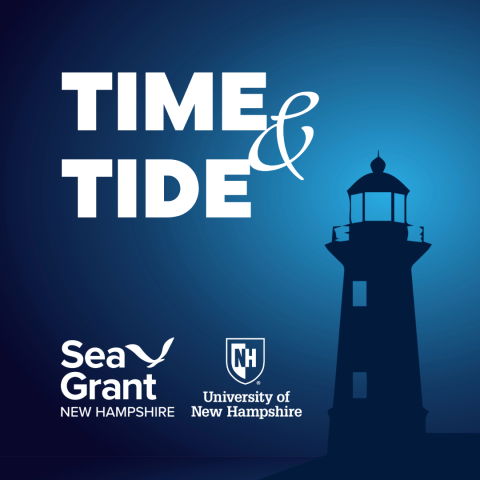
Time and Tide is a production of New Hampshire Sea Grant at the University of New Hampshire. Views expressed on this podcast are not necessarily those of the university, its trustees, or its volunteers.
New Hampshire Sea Grant works to enhance our relationship with the coastal environment to sustain healthy and resilient ecosystems, economies, and communities through integrated research, extension, education, and communications efforts. Based at the University of New Hampshire, New Hampshire Sea Grant is one of 34 programs in the National Oceanic and Atmospheric Administration’s National Sea Grant College Program, a state-federal partnership serving America’s coasts.
University of New Hampshire is an equal opportunity employer, learn more.

